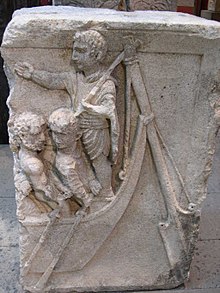Roman river trade
In addition to the Roman sea trade in the Mediterranean and the Atlantic, which was carried out with ocean-going ships such as the Corbitae , there were also smaller merchant ships and boats that were used to transport goods on rivers.
construction
These ships were rather small, shallow and basically only had a very shallow draft. A type of river barge used by the Romans on the Rhine was 30 meters long, 9 meters wide and had a draft of 70 cm. Such a ship could load between 150 and 100 tons of cargo. These barges only had very small keels because, unlike on the high seas, high waves in rivers did not pose a threat.
They were almost exclusively ships powered by rowers. It was steered with a large stern rudder, which was maneuvered using ropes (see picture).
history
River trade has always been important for the Roman Empire, including for the transport of goods on the Tiber and the Po . But it gained massive importance after the conquest of Gaul in 51 BC. By Gaius Iulius Caesar . For the Roman trade with Germanic tribes in the provinces of Norikum and Germania superior , even after the establishment of an extensive road network, the Roman river trade was an important, faster and cheaper means of transport.
See also
literature
- Donald S. Johnson: The Great Maritime History: 3,000 Years of Expeditions, Trade and Navigation . ISBN 978-3-86690074-5
Individual evidence
- ↑ Bürgererverein Daxlanden (ed.): Daxlanden: The local history . ISBN 978-3-88190466-7 , p. 141
